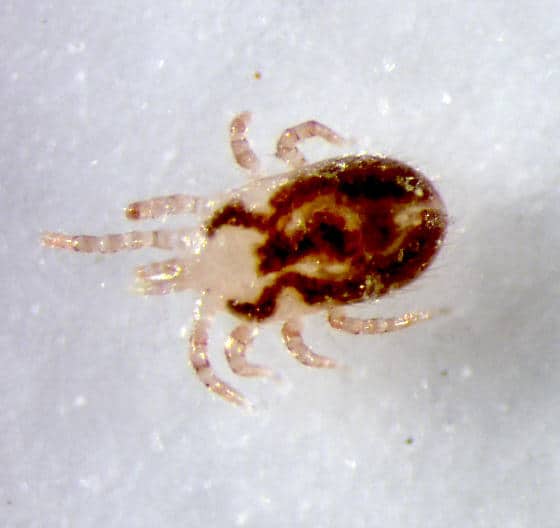There are several kinds of poultry mites that can cause problems in your backyard flock. Here is a list of common mite problems and how best to protect your flock.
What are Poultry Mites?
Mites are tiny wingless arachnids (unlike poultry lice that are insects) that are barely visible without the aid of magnification. They basically look like dark moving specks, when found on your chickens. Most of them feed on chicken blood, some of them also eat feathers. Most of them burrow into the chicken’s skin or leg scales, although some get into the lungs and other organs in poultry. At the very least, poultry mites will cause extreme discomfort to your flock. They also can cause anemia, lessen egg laying, and damage the skin of the chicken infested. They can also cause death, if left untreated.
Common causes for poultry mite infestation include exposure to wild birds that carry the mites, or introduction of new birds to your flock that are already infected.
Red Mites

These tiny poultry mites are red blood sucking bugs. They feed on your flock at night and live in the cracks and corners of the coop, or in nest boxes during the day. They don’t actually live on your birds.
If you notice your hens scratching and grooming themselves constantly and possibly even pulling her feathers out, red mites might be a problem. You also might notice tiny blood spots on the outside shells of the eggs you gather in the nest box. This could be from squashed red mites in the next box.
The best way to find these tiny mites is to inspect your hens at night, when they’re most likely to be present on their bodies. If you’re looking for these mites at night, take care to know you could be bitten by them. Bites to humans, though possibly painful and itchy, won’t cause problems any more than any other general bug bite.
To help discourage red mites from taking up residence in your chicken coop, keep the coop bedding clean. Also, when cleaning the coop, pay special attention to the corners and cracks, disinfecting the whole coop while you clean. Also, adding a sprinkling of diatomaceous earth to the floor before you add the bedding will help. Make sure you get in the cracks and corners with it as well.
Northern Fowl Mites

This kind of poultry mite actually lives on your chickens instead of the coop as the red mites do. They generally wreak havoc on your poor hens! Like the red mites, the northern fowl mites suck the blood of your chickens, both during the day and at night.
>These nasty little mites cause similar symptoms as the red mite variety, possibly even causing anemia in your flock. Additionally, look for paler combs and a drop off in egg laying as possible red flags for these mites being present.
Also, if looking on your birds for these mites, look under the wings for both mites and mite eggs, and in the feathers both above and below the vent. Again, these mites might also bite humans, resulting in itchy, irritating spots, but won’t harm you beyond that.
To help discourage northern fowl mites, make sure your chickens have an adequate place to perform their dust bathing routines on a regular basis. Sprinkle the dust bathing area with a little diatomaceous earth from time to time. Use poultry dust on your hens occasionally.
Scaly Leg Mites
Another irritating poultry mite is the Scaly Leg Mite. As the name suggests, they’re found on the legs of infested hens, burrowing under the scales and causing misery.
Look for signs of this mite in the condition of the legs as these mites are too small to be seen with the naked eye. If the scales look crusty, brittle, flaky, or otherwise misshapen, you might have a problem. If the problem persists, lesions or scabs will form on the legs and eventually deformation and crippling will occur.
Good prevention of scaly leg mites is making sure your coop stays clean and dry. Pay special attention to chickens with feathers on their legs and feet, as they’re not only more susceptible to this variety of mites, but it’s also harder to see them when they’re present as the scales are largely covered up.
If you’d like to see photos of the mites discussed above, and learn more in-depth information about them, here’s an article on poultry mites and lice from the University of California.